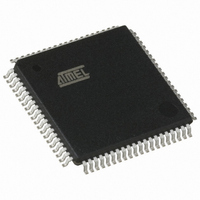AT89C51SND1C-ROTUL Atmel, AT89C51SND1C-ROTUL Datasheet - Page 110

AT89C51SND1C-ROTUL
Manufacturer Part Number
AT89C51SND1C-ROTUL
Description
IC 8051 MCU FLASH 64K MP3 80TQFP
Manufacturer
Atmel
Series
89Cr
Datasheet
1.AT80C51SND1C-ROTIL.pdf
(213 pages)
Specifications of AT89C51SND1C-ROTUL
Core Processor
8051
Core Size
8-Bit
Speed
40MHz
Connectivity
I²C, IDE/ATAPI, MMC, SPI, UART/USART, USB
Peripherals
Audio, I²S, MP3, PCM, POR, WDT
Number Of I /o
44
Program Memory Size
64KB (64K x 8)
Program Memory Type
FLASH
Ram Size
2.25K x 8
Voltage - Supply (vcc/vdd)
2.7 V ~ 3.3 V
Data Converters
A/D 2x10b
Oscillator Type
External
Operating Temperature
-40°C ~ 85°C
Package / Case
80-TQFP, 80-VQFP
Lead Free Status / RoHS Status
Lead free / RoHS Compliant
Eeprom Size
-
Available stocks
Company
Part Number
Manufacturer
Quantity
Price
- Current page: 110 of 213
- Download datasheet (3Mb)
16.2.1
16.2.2
110
AT8xC51SND1C
Bus Lines
Bus Protocol
The bus communication uses a special protocol (MultiMedia Card bus protocol) which is applica-
ble for all devices. Therefore, the payload data transfer between the host and the cards can be
bi-directional.
The MultiMedia Card bus architecture requires all cards to be connected to the same set of
lines. No card has an individual connection to the host or other devices, which reduces the con-
nection costs of the MultiMedia Card system.
The bus lines can be divided into three groups:
•
•
•
After a power-on reset, the host must initialize the cards by a special message-based MultiMe-
dia Card bus protocol. Each message is represented by one of the following tokens:
•
•
•
Card addressing is implemented using a session address assigned during the initialization
phase, by the bus controller to all currently connected cards. Individual cards are identified by
their CID number. This method requires that every card will have an unique CID number. To
ensure uniqueness of CIDs the CID register contains 24 bits (MID and OID fields) which are
defined by the MMCA. Every card manufacturers is required to apply for an unique MID (and
optionally OID) number.
MultiMedia Card bus data transfers are composed of these tokens. One data transfer is a bus
operation. There are different types of operations. Addressed operations always contain a com-
mand and a response token. In addition, some operations have a data token, the others transfer
their information directly within the command or response structure. In this case no data token is
present in an operation. The bits on the MDAT and the MCMD lines are transferred synchronous
to the host clock.
2 types of data transfer commands are defined:
•
•
Figure 16-1 through Figure 16-5 show the different types of operations, on these figures, grayed
tokens are from host to card(s) while white tokens are from card(s) to host.
Power supply: V
Data transfer: MCMD, MDAT – used for bi-directional communication.
Clock: MCLK – used to synchronize data transfer across the bus.
Command: a command is a token which starts an operation. A command is transferred
serially from the host to the card on the MCMD line.
Response: a response is a token which is sent from an addressed card (or all connected
cards) to the host as an answer to a previously received command. It is transferred serially
on the MCMD line.
Data: data can be transferred from the card to the host or vice-versa. Data is transferred
serially on the MDAT line.
Sequential commands: These commands initiate a continuous data stream, they are
terminated only when a stop command follows on the MCMD line. This mode reduces the
command overhead to an absolute minimum.
Block-oriented commands: These commands send a data block succeeded by CRC bits.
Both read and write operations allow either single or multiple block transmission. A multiple
block transmission is terminated when a stop command follows on the MCMD line similarly
to the stream read.
SS1
and V
SS2
, V
DD
– used to supply the cards.
4109L–8051–02/08
Related parts for AT89C51SND1C-ROTUL
Image
Part Number
Description
Manufacturer
Datasheet
Request
R

Part Number:
Description:
Mp3 Microcontrollers
Manufacturer:
ATMEL Corporation
Datasheet:

Part Number:
Description:
BOARD DEMO MP3 PLAYER
Manufacturer:
Atmel
Datasheet:

Part Number:
Description:
DEV KIT FOR AVR/AVR32
Manufacturer:
Atmel
Datasheet:

Part Number:
Description:
INTERVAL AND WIPE/WASH WIPER CONTROL IC WITH DELAY
Manufacturer:
ATMEL Corporation
Datasheet:

Part Number:
Description:
Low-Voltage Voice-Switched IC for Hands-Free Operation
Manufacturer:
ATMEL Corporation
Datasheet:

Part Number:
Description:
MONOLITHIC INTEGRATED FEATUREPHONE CIRCUIT
Manufacturer:
ATMEL Corporation
Datasheet:

Part Number:
Description:
AM-FM Receiver IC U4255BM-M
Manufacturer:
ATMEL Corporation
Datasheet:

Part Number:
Description:
Monolithic Integrated Feature Phone Circuit
Manufacturer:
ATMEL Corporation
Datasheet:

Part Number:
Description:
Multistandard Video-IF and Quasi Parallel Sound Processing
Manufacturer:
ATMEL Corporation
Datasheet:

Part Number:
Description:
High-performance EE PLD
Manufacturer:
ATMEL Corporation
Datasheet:

Part Number:
Description:
8-bit Flash Microcontroller
Manufacturer:
ATMEL Corporation
Datasheet:

Part Number:
Description:
2-Wire Serial EEPROM
Manufacturer:
ATMEL Corporation
Datasheet:











